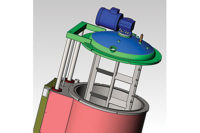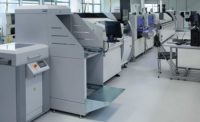Porsche, Lamborghini and other European luxury vehicle manufacturers build cars that are stunning on the outside. But, it’s often Eissmann Group Automotive that makes the vehicle’s interior look just as beautiful.
Based in Bad Urach, Germany, Eissmann makes high-quality, embossed-leather coverings for steering wheels, center consoles, instrument panels, armrests and doors. The company started in 1964 by making wheel covers for the Volkswagen Beetle before switching to leather work a few years later. It also supplies combined shifter modules.
Some workers at Eissmann use manual sewing machines to apply logos, pictograms or designs to the leather covering, while others operate fully automated equipment. This work breakdown is followed at all 13 of the company’s production facilities worldwide.
Since 2015, Oliver Roser, a plant-construction designer at Eissmann, and Klaus Kränzler, an electronics designer at Eissmann, have developed five machines for embossing leather on steering-wheel air bag covers at Eissmann plants in Hungary and Mexico.
“The challenge is that the symbols should always look identical,” says Roser. “The left-hand horn should be exactly like the one on the right. What’s more, the whole process is critical for safety, because we’re operating in the area of the predetermined trigger point for the driver’s air bag.”
Genuine leather is applied and bonded to the air bag cover, which is made of injection-molded plastic. The brand logo and car horn symbols are then automatically embossed into the leather with a compact NCFH joining module made by the Kistler Group.
“In the past, we used standard solutions for the embossing, but they caused problems,” explains Roser. “There were often differences in the appearance of the symbols, and the stability of the process wasn’t particularly good, which meant considerable outlay on reworking.
“With the new machines, the air bags are pressed against the embossing die from below. Spindles positioned behind the tool changer move the dies as required to establish simultaneous contact with the leather. The modules allow very precise monitoring of force and displacement, so the pressure force can be adjusted accurately.”
An integrated maXYmos NC monitoring system automatically measures this displacement while compensating for the frequent tolerance changes that occur with a natural material such as leather. It also improves traceability and easily integrates with Eissmann’s manufacturing execution system software.
The plug-and-play NCFH module features a direct-drive motor that ensures constant acceleration and velocity, short cycle times and little embossing rework. It also provides real-time force control via a servo amplifier, allows for quick programming and presetting, and features operator-friendly software.
MaXYmos NC is used with NC joining modules, and its motor is controlled by the servo amplifier IndraDrive. This drive features a power section with firmware, a parameter set, a safety zone box and all cables.
“We’re so satisfied with this solution that we’ll be deploying more Kistler systems in our plants as time goes on,” says Roser. “[Being able to] adapt the embossing die means that we save several hours and quite a few test parts when a new tool is introduced.”
The company also expects the Kistler-based embossing machines to help it continue a trend, since 2009, of annually increasing income. For more information on joining modules and force-displacement measuring systems, call 248-668-6900 or visit www.kistler.com.




